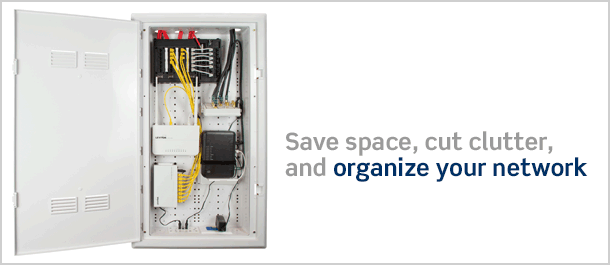A Connected Home Begins with Planning

The number of connected devices in the home has grown significantly over the last few years. To adequately support this trend, it is important to build residential networks on an organized structured cabling foundation.
Too often, homeowners knowingly accept poor network reliability and quality for the convenience of a wireless system. While wireless technology has improved, the hunger for bandwidth outpaces it. Modern homes use an average of six connected devices per household, including 4K and Ultra HD TVs, VOIP, streaming media servers, and game consoles, as well as internet-enabled printers, thermostats, appliances, and more.
No one using the latest consumer technologies should accept poor network quality and low data rates. High-speed, hard-wired structured cabling offers the ideal solution to support today’s demands. Wi-Fi should be designed as an extension of a well-planned home networking array, not the sole connectivity option.
Residential structured cabling combines concepts from demanding commercial cabling applications with multimedia to accommodate audio, video, voice, data, and security systems. The smartest home networks use wired connectivity for stationary devices like Blu-ray® players, desktop computers, set-top boxes, and game consoles, and then add a wireless router to provide the strongest Wi-Fi signal to portable devices such as tablets, laptops, and phones.
If installed during new construction, a well-planned structured cabling system benefits the homeowner and increases the value of the home. But even if that opportunity has passed, there is great value in organizing the various systems into a unified design to reduce overall cost, provide maximum functionality, and maintain an aesthetically pleasing result.
To prepare for home network growth, it is important that homeowners organize their connections. A structured wiring panel or enclosure serves as the central hub for a network, and is an excellent option for housing routers, switches, modems, and more in one place. Mantels, entertainment centers, and desktops can quickly become overcrowded and cluttered, making it difficult to troubleshoot problems. By consolidating the network in a structured wiring enclosure, homeowners save valuable space, eliminate clutter, and have easy access to all of their connected devices.

Achieving a Digital Lifestyle
The first step is to lay out all the systems you want integrated into the home. Work backwards: start with the applications you want in every room and then plan the wiring to support them. Each system is going to have its own set of requirements for cabling, infrastructure, power, installation location, and devices used to manage and control them. We recommend installing Category 6 cabling for its performance and bandwidth advantages. Cabling standards from TIA and BICSI also recommend Category 6, and require Category 5e at a minimum.
The next step is to plan out the components needed for the various systems. Depending on the number of phone lines and internet extension locations, there are options for modules that serve as a routing point for voice and data networks. These modules give the homeowner flexibility and control over the systems just as they do in commercial buildings.
The final step is bringing the various cabling systems back to the structured wiring enclosure, similar to how a breaker box is the hub of the electrical system. Structured wiring enclosures fit between standard construction stud spaces (see photo) and accommodate everything from a small apartment-sized network to large custom homes with many system applications.
The structured wiring enclosure also serves as the hub for entertainment options. A coaxial cable coming from the cable service or satellite television provider connects to a splitter located in the media enclosure and branches out to deliver video content to multiple rooms. Whole- house audio systems can be routed through the enclosure and can be controlled by wall-mounted switches. Some installations even include home theater applications.
Many options are available to meet the needs of the homeowner’s digital lifestyle. Having a strong structured wiring backbone in an organized central hub is crucial to supporting high-bandwidth demands and optimal wireless performance.
This article was originally published in the NEMA EI Magazine, which can be viewed here


